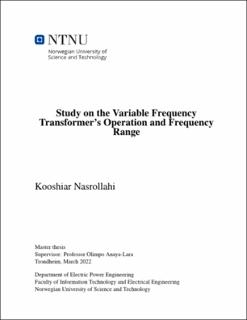| dc.description.abstract | Inherently variable power generation from renewable energy sources (RES), such as wind turbines and solar panels, is challenging for energy shifting. Merging separated power grids into a super grid with various RES besides the different peak times and seasons in distinct regions help to overcome the RES fluctuations. The variable frequency transformer (VFT) asynchronous grids interconnection offers flexible power flow between different areas, developing power grids' reliability and balancing mismatches in supply and demand in an area.
The recent shift from conventional synchronous power generation plants to wind power and PVs reduces power systems' frequency stability. Increasing full-converter wind turbines, which isolate the generator rotational speed from the grid frequency, decreases the power system's physical inertia. PV power plants also miss any physical inertia. Physical inertia is vital in the early stage of the frequency disturbances for power systems' stability. General power systems' frequency droop characteristic suggests that employing a VFT, which has significantly high inertia constant, improves the power system's frequency stability. Also, the VFT fundamental structure offers frequency ancillary service in frequency transient of rotor swing, stage I, inertial frequency drop, stage II, primary control, stage III, and secondary control, stage IV. Utilising the VFT interconnection with energy storage banks (ESB) show similar dynamics to a synchronous generator. The VFT bidirectional power transfer capability contributes to both over and under power mismatch.
This study reviewed the VFT operating and power systems' frequency transient response to analysing the VFT behaviour during the frequency shifting operation and possible involvement in inertial, primary, and secondary frequency control. The VFT behaviour is analysed and tested in the MATLAB\Simulink. This study focuses on the maximum possible active power transmission during frequency shifting and the VFT's frequency drop characteristic during a frequency disturbance. | |
